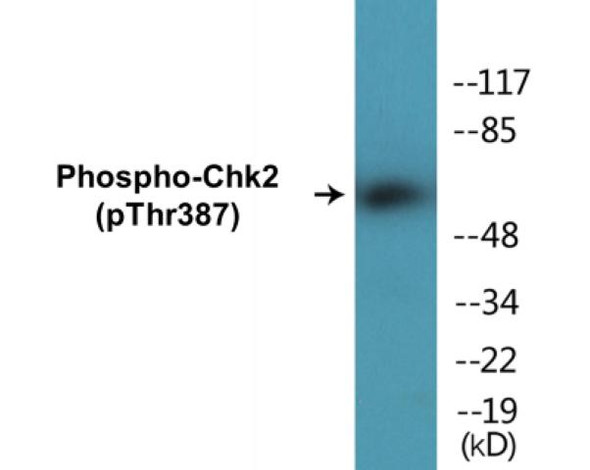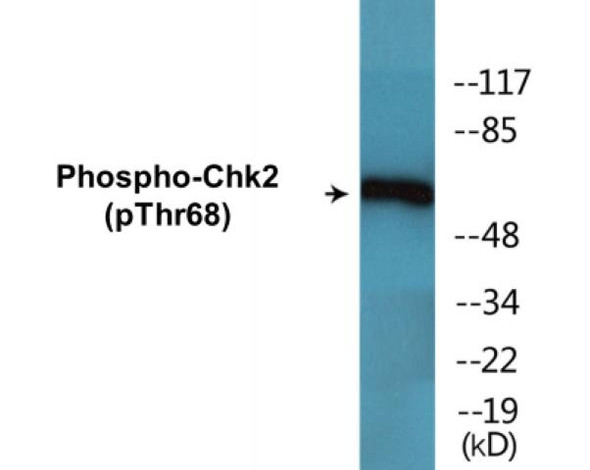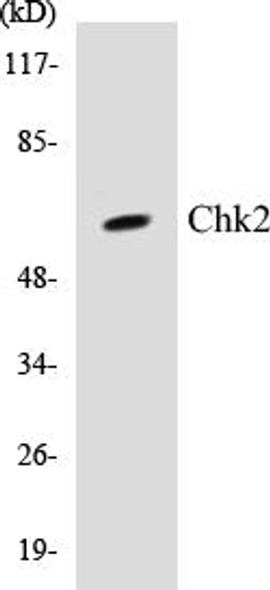Description
Chk2 (Phospho-Ser516)Colorimetric Cell-Based ELISA Kit
The CHK2 Phospho-Ser516 Colorimetric Cell-Based ELISA Kit is a powerful tool for studying the phosphorylation status of CHK2 at serine 516 in cell lysates. This kit provides high sensitivity and specificity for detecting the phospho-ser516 CHK2 protein, allowing for accurate and reliable results in a variety of experimental settings.CHK2 is a key regulator of cell cycle checkpoints and DNA damage response pathways, playing a critical role in maintaining genomic stability and preventing the proliferation of damaged cells. Phosphorylation of CHK2 at serine 516 is a crucial event in its activation and signaling cascade, making it an important target for studying cellular stress responses and DNA repair mechanisms.
By utilizing the CHK2 Phospho-Ser516 Colorimetric Cell-Based ELISA Kit, researchers can gain valuable insights into the activation status of CHK2 in response to various stimuli, furthering our understanding of cell cycle regulation, DNA damage repair, and cancer progression. This kit is suitable for a wide range of applications in cell biology, cancer research, and drug development, making it an essential tool for advancing scientific knowledge and therapeutic intervention.
| Product Name: | Chk2 (Phospho-Ser516)Colorimetric Cell-Based ELISA Kit |
| Product Code: | CBCAB01508 |
| ELISA Type: | Cell-Based |
| Target: | Chk2 (Phospho-Ser516) |
| Reactivity: | Human |
| Dynamic Range: | > 5000 Cells |
| Detection Method: | Colorimetric 450 nm |
| Format: | 2 x 96-Well Microplates |
The Chk2 (Phospho-Ser516) Colorimetric Cell-Based ELISA Kit is a convenient, lysate-free, high throughput and sensitive assay kit that can detect Chk2 protein phosphorylation and expression profile in cells. The kit can be used for measuring the relative amounts of phosphorylated Chk2 in cultured cells as well as screening for the effects that various treatments, inhibitors (ie. siRNA or chemicals), or activators have on Chk2 phosphorylation.
Qualitative determination of Chk2 (Phospho-Ser516) concentration is achieved by an indirect ELISA format. In essence, Chk2 (Phospho-Ser516) is captured by Chk2 (Phospho-Ser516)-specific primary (1ø) antibodies while the HRP-conjugated secondary (2ø) antibodies bind the Fc region of the 1ø antibody. Through this binding, the HRP enzyme conjugated to the 2ø antibody can catalyze a colorimetric reaction upon substrate addition. Due to the qualitative nature of the Cell-Based ELISA, multiple normalization methods are needed:
| 1. | A monoclonal antibody specific for human GAPDH is included to serve as an internal positive control in normalizing the target absorbance values. |
| 2. | Following the colorimetric measurement of HRP activity via substrate addition, the Crystal Violet whole-cell staining method may be used to determine cell density. After staining, the results can be analysed by normalizing the absorbance values to cell amounts, by which the plating difference can be adjusted. |
| Database Information: | Gene ID: 11200, UniProt ID: O96017, OMIM: 176807/259500/604373/609265, Unigene: Hs.291363/Hs.505297 |
| Gene Symbol: | CHEK2 |
| Sub Type: | Phospho |
| UniProt Protein Function: | Chk2: a CAMK protein kinase of the Rad53 family. A cell cycle checkpoint regulator and putative tumor suppressor. It contains a forkhead-associated protein interaction domain essential for activation in response to DNA damage and is rapidly phosphorylated in response to replication blocks and DNA damage. Phosphorylates and inhibits CDC25C, preventing entry into mitosis, p53, leading to cell cycle arrest in G1, and BRCA1, restoring survival after DNA damage. Twelve splice variant isoforms have been described for human Chk2. LOF mutants cause Li-Fraumeni syndrome, a highly penetrant familial cancer phenotype also caused by p53 mutations. Familial mutations also associated with prostate and breast cancer, and mutations also seen in a variety of sporadic cancers and cell lines. |
| UniProt Protein Details: | Protein type:EC 2.7.11.1; Kinase, protein; Protein kinase, Ser/Thr (non-receptor); Protein kinase, CAMK; Tumor suppressor; CAMK group; RAD53 family Chromosomal Location of Human Ortholog: 22q12.1 Cellular Component: nucleoplasm; Golgi apparatus; PML body; chromosome, telomeric region Molecular Function:protein serine/threonine kinase activity; identical protein binding; protein binding; protein homodimerization activity; metal ion binding; ubiquitin protein ligase binding; protein kinase binding; ATP binding Biological Process: DNA damage induced protein phosphorylation; transcription, DNA-dependent; protein stabilization; protein amino acid autophosphorylation; positive regulation of transcription, DNA-dependent; DNA damage response, signal transduction; protein amino acid phosphorylation; regulation of transcription, DNA-dependent; DNA damage response, signal transduction resulting in induction of apoptosis; cell division; cellular protein catabolic process; double-strand break repair; DNA damage checkpoint; response to gamma radiation; regulation of protein catabolic process; G2/M transition of mitotic cell cycle; response to DNA damage stimulus Disease: Li-fraumeni Syndrome 2; Breast Cancer; Prostate Cancer; Osteogenic Sarcoma |
| NCBI Summary: | In response to DNA damage and replication blocks, cell cycle progression is halted through the control of critical cell cycle regulators. The protein encoded by this gene is a cell cycle checkpoint regulator and putative tumor suppressor. It contains a forkhead-associated protein interaction domain essential for activation in response to DNA damage and is rapidly phosphorylated in response to replication blocks and DNA damage. When activated, the encoded protein is known to inhibit CDC25C phosphatase, preventing entry into mitosis, and has been shown to stabilize the tumor suppressor protein p53, leading to cell cycle arrest in G1. In addition, this protein interacts with and phosphorylates BRCA1, allowing BRCA1 to restore survival after DNA damage. Mutations in this gene have been linked with Li-Fraumeni syndrome, a highly penetrant familial cancer phenotype usually associated with inherited mutations in TP53. Also, mutations in this gene are thought to confer a predisposition to sarcomas, breast cancer, and brain tumors. This nuclear protein is a member of the CDS1 subfamily of serine/threonine protein kinases. Several transcript variants encoding different isoforms have been found for this gene. [provided by RefSeq, Apr 2012] |
| UniProt Code: | O96017 |
| NCBI GenInfo Identifier: | 6685284 |
| NCBI Gene ID: | 11200 |
| NCBI Accession: | O96017.1 |
| UniProt Secondary Accession: | O96017,Q6QA03, Q6QA04, Q6QA05, Q6QA06, Q6QA07, Q6QA08 Q6QA10, A8K3Y9, B7ZBF3, B7ZBF4, B7ZBF5, |
| UniProt Related Accession: | O96017 |
| Molecular Weight: | 543 |
| NCBI Full Name: | Serine/threonine-protein kinase Chk2 |
| NCBI Synonym Full Names: | checkpoint kinase 2 |
| NCBI Official Symbol: | CHEK2 |
| NCBI Official Synonym Symbols: | CDS1; CHK2; LFS2; RAD53; hCds1; HuCds1; PP1425 |
| NCBI Protein Information: | serine/threonine-protein kinase Chk2; cds1 homolog; CHK2 checkpoint homolog; checkpoint-like protein CHK2 |
| UniProt Protein Name: | Serine/threonine-protein kinase Chk2 |
| UniProt Synonym Protein Names: | CHK2 checkpoint homolog; Cds1 homolog; Hucds1; hCds1; Checkpoint kinase 2 |
| Protein Family: | Serine/threonine-protein kinase |
| UniProt Gene Name: | CHEK2 |
| UniProt Entry Name: | CHK2_HUMAN |
| Component | Quantity |
| 96-Well Cell Culture Clear-Bottom Microplate | 2 plates |
| 10X TBS | 24 mL |
| Quenching Buffer | 24 mL |
| Blocking Buffer | 50 mL |
| 15X Wash Buffer | 50 mL |
| Primary Antibody Diluent | 12 mL |
| 100x Anti-Phospho Target Antibody | 60 µL |
| 100x Anti-Target Antibody | 60 µL |
| Anti-GAPDH Antibody | 60 µL |
| HRP-Conjugated Anti-Rabbit IgG Antibody | 12 mL |
| HRP-Conjugated Anti-Mouse IgG Antibody | 12 mL |
| SDS Solution | 12 mL |
| Stop Solution | 24 mL |
| Ready-to-Use Substrate | 12 mL |
| Crystal Violet Solution | 12 mL |
| Adhesive Plate Seals | 2 seals |
The following materials and/or equipment are NOT provided in this kit but are necessary to successfully conduct the experiment:
- Microplate reader able to measure absorbance at 450 nm and/or 595 nm for Crystal Violet Cell Staining (Optional)
- Micropipettes with capability of measuring volumes ranging from 1 µL to 1 ml
- 37% formaldehyde (Sigma Cat# F-8775) or formaldehyde from other sources
- Squirt bottle, manifold dispenser, multichannel pipette reservoir or automated microplate washer
- Graph paper or computer software capable of generating or displaying logarithmic functions
- Absorbent papers or vacuum aspirator
- Test tubes or microfuge tubes capable of storing ≥1 ml
- Poly-L-Lysine (Sigma Cat# P4832 for suspension cells)
- Orbital shaker (optional)
- Deionized or sterile water
*Note: Protocols are specific to each batch/lot. For the correct instructions please follow the protocol included in your kit.
| Step | Procedure |
| 1. | Seed 200 µL of 20,000 adherent cells in culture medium in each well of a 96-well plate. The plates included in the kit are sterile and treated for cell culture. For suspension cells and loosely attached cells, coat the plates with 100 µL of 10 µg/ml Poly-L-Lysine (not included) to each well of a 96-well plate for 30 minutes at 37 °C prior to adding cells. |
| 2. | Incubate the cells for overnight at 37 °C, 5% CO2. |
| 3. | Treat the cells as desired. |
| 4. | Remove the cell culture medium and rinse with 200 µL of 1x TBS, twice. |
| 5. | Fix the cells by incubating with 100 µL of Fixing Solution for 20 minutes at room temperature. The 4% formaldehyde is used for adherent cells and 8% formaldehyde is used for suspension cells and loosely attached cells. |
| 6. | Remove the Fixing Solution and wash the plate 3 times with 200 µL 1x Wash Buffer for five minutes each time with gentle shaking on the orbital shaker. The plate can be stored at 4 °C for a week. |
| 7. | Add 100 µL of Quenching Buffer and incubate for 20 minutes at room temperature. |
| 8. | Wash the plate 3 times with 1x Wash Buffer for 5 minutes each time. |
| 9. | Add 200 µL of Blocking Buffer and incubate for 1 hour at room temperature. |
| 10. | Wash 3 times with 200 µL of 1x Wash Buffer for 5 minutes each time. |
| 11. | Add 50 µL of 1x primary antibodies Anti-Chk2 (Phospho-Ser516) Antibody, Anti-Chk2 Antibody and/or Anti-GAPDH Antibody) to the corresponding wells, cover with Parafilm and incubate for 16 hours (overnight) at 4 °C. If the target expression is known to be high, incubate for 2 hours at room temperature. |
| 12. | Wash 3 times with 200 µL of 1x Wash Buffer for 5 minutes each time. |
| 13. | Add 50 µL of 1x secondary antibodies (HRP-Conjugated AntiRabbit IgG Antibody or HRP-Conjugated Anti-Mouse IgG Antibody) to corresponding wells and incubate for 1.5 hours at room temperature. |
| 14. | Wash 3 times with 200 µL of 1x Wash Buffer for 5 minutes each time. |
| 15. | Add 50 µL of Ready-to-Use Substrate to each well and incubate for 30 minutes at room temperature in the dark. |
| 16. | Add 50 µL of Stop Solution to each well and read OD at 450 nm immediately using the microplate reader. |
(Additional Crystal Violet staining may be performed if desired – details of this may be found in the kit technical manual.)






